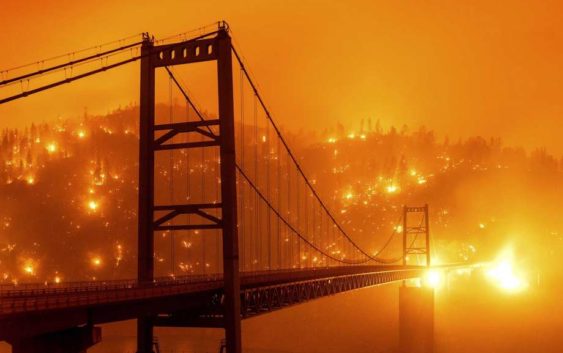- McDowell County wildfire spreads to 500 acres, evacuation orders in place
- Evacuations in Caldwell County due to wildfire
- Northwest Houston 'ghost neighborhood' caused by repeated flooding to become latest detention basin
- NHL playoffs: Hurricanes open playoffs Easter Sunday afternoon vs. Devils
- 2 wildfires spreading in rugged terrain in western North Carolina
Could California-esque wildfires happen in San Antonio? Here’s what the Fire Chief said.

-
In this Sept. 9, 2020, file photo, taken with a slow shutter speed, embers light up a hillside behind the Bidwell Bar Bridge as the Bear Fire burns in Oroville, Calif.
In this Sept. 9, 2020, file photo, taken with a slow shutter speed, embers light up a hillside behind the Bidwell Bar Bridge as the Bear Fire burns in Oroville, Calif.
Photo: Noah Berger, AP
In this Sept. 9, 2020, file photo, taken with a slow shutter speed, embers light up a hillside behind the Bidwell Bar Bridge as the Bear Fire burns in Oroville, Calif.
In this Sept. 9, 2020, file photo, taken with a slow shutter speed, embers light up a hillside behind the Bidwell Bar Bridge as the Bear Fire burns in Oroville, Calif.
Photo: Noah Berger, AP
Wildfires have wreaked havoc on the West Coast in recent weeks, burning millions of acres as plumes of smoke travel as far as Britain.
In California alone, at least 25 people have died and nearly 5,400 structures have been destroyed.
Although San Antonio has yet to experience destruction from wildfires on anything approaching that scale, Fire Chief Charles Hood said the area shares several contributing elements with California.
READ ALSO: Texas Gov.: Restaurants, retailers can expand capacity but bars must stay closed
North of the city — particularly in Stone Oak and The Dominion — communities have been built in areas that are heavily vegetated, with houses dotting rocky hills. A Texas A&M Forest Service risk assessment map reveals a red band of high wildfire risk from Helotes to the Interstate 35 corridor.
“We are not at the scale of what’s going on in California, but we do have some of the same dynamics here that could set us up for a fire that could devastate a neighborhood or a portion of this region,” Hood said.
In 2017, a brush fire at Camp Bullis — and the knowledge the flames could burn out of control in the hills with windy conditions — prompted the fire department to put together a plan for evacuating residents from The Dominion.
A fire line, or gap in the brush intended to slow or stop the fire’s spread, was created to protect the gated community. Firefighters stamped the blaze out on-base.
“We did have evacuation plans in place,” Hood recalled. “Thank God we never had to use those.”
The following year, San Antonio firefighters participated in a wildfire simulation at the Roseheart retirement community on the North Side. The exercise was conducted in December. Hood noted that brush fires often spring up in the winter when vegetation dries out.
The department’s wildland program now counts 60 members, each with 100 hours of initial training, along with 11 brush trucks and a helicopter. Seven SAFD firefighters are picking up some additional hard-earned experience battling the California blazes this month.
Fighting wildfires requires specialized training because they are more challenging than a standard structure fire, where hydrants are ever-present and a cul-de-sac could present the toughest obstacle.
A wildland fire might demand driving miles on an unpaved road, burning vegetation before the fire arrives to cut off its fuel, and bringing in water with helicopter buckets.
Chief Hood said his department uses prescribed burns to clear some of the vegetation that fuels such fires. He’s also pushing to educate the public, so high grass or items stacked next to a wood fence do not prove to be an accelerant for a blaze.
Nine Bexar County communities, including several in Converse, have participated in the Firewise preparation program.
Two of the main causes of fires are lightning strikes and downed power lines. But there are other sources, like fireworks, and Hood said one in particular drives him crazy: cigarettes.
That patch of burned grass you’ve noticed on the side of Loop 1604 or U.S. 281?
It probably started because someone flicked a lit cigarette out their car window, according to the chief. Such fires are especially dangerous because firefighters have to pull hoses on the side of the road while drivers speeding by peer through smoke.
So keep the cigarettes off the roads, or risk becoming the next person to accidently spark a wildfire.